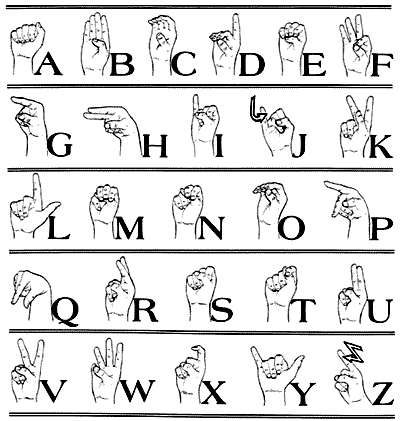ASL Guidelines
I learned American Sign Language, which I’ll abbreviate to ASL from this point forward, when I was just two years old. I then took up English immediately after, and those are the only two languages that I’m fluent in today. (Here’s my preemptive apology to all the people fluent in Japanese; if you know me, you understand this.) My English is relatively better than my ASL, since I practice the former more, but I can still understand ASL well. For many years, I was cognizant of the various ways to emphasize signs to display various levels of expression. One of the things that I didn’t comprehend until just recently, however, was the amazing web of syntax and grammar rules in ASL. Many involve body movement and contortions of the English language that are not entirely instinctive.
I was formally introduced to ASL Syntax when I was a freshman at Williams College as a teaching assistant to the RUSS 12 – Introduction to American Sign Language course offered for Winter Study, the four-week period between the first and second semesters. Previously, I never had anyone tell me that the correct way to ask a yes or no question was with eyebrows pushed up. Similarly, signing a phrase with the translated English equivalent of “I teacher” was equivalent to the non-translated English equivalent of “I am a teacher.” (I knew this in middle and high school intrinsically; getting it described to me made it pleasantly clear.) This was all interesting to me, so I absorbed – and hopefully retained – the material just as well as the students in RUSS 12 if not more. Here are a handful of the rules that every person knowing ASL should follow. I’ll call them the 10 Seita Axioms, because it’s not illegal to do so.
Axiom I: Signing an English phrase word-by-word is discouraged.
Axiom II: Never sign the word “is.” This rule generally applies to all prepositions.
Axiom III: While asking yes/no questions, keep your eyebrows tilted up.
Axiom IV: While asking a who/what/where/when/why question, keep your eyebrows tilted down.
Axiom V: Use of classifiers is encouraged.
Axiom VI: Mouth the words that you sign, but do not use your voice.
Axiom VII: Emphasize the tone of your signs.
Axiom VIII: Make prudent use of indexing.
Axiom IX: The simplest way to manage personal pronouns is to point.
Axiom X: Use inflection to modify your signing; this aids brevity and clarity.
“Footnotes” for each axiom, which will probably need its own article.
Axiom I Footnote: If you do so, you’re signing Signed Exact English (abbreviated SEE).
Axiom II Footnote: There are other words that you shouldn’t sign, as I mention in the following sentence in the axiom, but “is” is probably the most incongruous of words to sign in ASL. I felt it was prudent to give it an axiom to itself.
Axiom III Footnote: Fairly self-explanatory.
Axiom IV Footnote: Think of it as a way of representing confusion. Sometimes it occurs instinctively when asking someone a question in English.
Axiom V Footnote: Classifiers here are signs that can represent the form, movement, or appearance of an object. For instance, to indicate someone’s walking, you could just slide your index finger across your body.
Axiom VI Footnote: If you speak while signing at the same time, it’s like you’re expressing two different languages simultaneously. While it can be helpful in situations when you’re communicating with a person who only knows ASL and another person who only knows English, it’s frowned upon in the deaf community.
Axiom VII Footnote: If you’re just a little mad, move your hands up quickly but briefly. If you’re at the level of madness where it’s not safe for someone to be within a one-mile radius of you … we need to see that in the sign.
Axiom VIII Footnote: If you’re talking about Bob and Sarah, point to the left if you want to describe Bob, and to the right for Sarah. Clearly, this becomes impractical with a large number of objects. In that case, just be sure to clarify what you’re signing beforehand.
Axiom IX Footnote: To sign the general word “he,” point your finger in the air.
Axiom X Footnote: If you’re very happy that something is done, instead of signing the cumbersome “very,” just emphasize the “very” when signing “happy.” Think of it as the difference between “I am happy” and “I am HAPPY.”
Above is, literally, my first attempt in creating a set of concise yet comprehensive ASL guidelines. I hope to eventually update to version 2, version 3, and so forth. I would copyright this, but I stole this idea from another deaf person who postulated these axioms (just kidding). © 2011 Daniel Seita. See? I can do this stuff. I now feel obligated to send my computer science professor a thank-you note for encouraging us to copyright all of our writing. Maybe I can get extra credit.
Before I end this post (which, sadly, coincides with the end of a Williams College class recess), I’d like to provide some references. A great website that contains much of what I said and more is Lifeprint, which was created by Bill Vicars. This website was used in RUSS 12. Additionally, there are numerous online dictionaries available that may include more signs. I’ve listed one below the Lifeprint link.
(I’ve had problems with the last link, but maybe it’s because I use a Macbook Pro.)
I did not include “knowing the alphabet” since that should be acquired before doing ANY sign language at all. Seriously, if you can’t sign the alphabet on one hand in less than ten seconds, review the signs. Meanwhile, I’m going to explore the Internet a bit more and see what revisions to make to my axioms.
